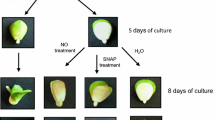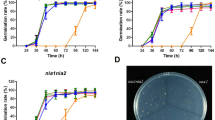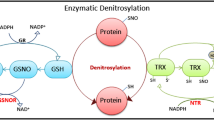Abstract
Main conclusion
NO donors and Arg remove dormancy of apple embryos and stimulate germination. Compounds lowering NO level (cPTIO, L -NAME, CAN) strengthen dormancy. Embryo transition from dormancy state to germination is linked to increased nitric oxide synthase (NOS)-like activity. Germination of embryos is associated with declined level of biotin containing proteins and nitrated proteins in soluble protein fraction of root axis. Pattern of nitrated proteins suggest that storage proteins are putative targets of nitration.
Nitric oxide (NO) acts as a key regulatory factor in removal of seed dormancy and is a signal necessary for seed transition from dormant state into germination. Modulation of NO concentration in apple (Malus domestica Borkh.) embryos by NO fumigation, treatment with NO donor (S-nitroso-N-acetyl-d,l-penicillamine, SNAP), application of 2-(4-carboxyphenyl)-4,4,5,5-tetramethylimidazoline-1-oxyl-3-oxide (cPTIO), N ω-nitro-l-arginine methyl ester (l-NAME), canavanine (CAN) or arginine (Arg) allowed us to investigate the NO impact on seed dormancy status. Arg analogs and NO scavenger strengthened embryo dormancy by lowering reactive nitrogen species level in embryonic axes. This effect was accompanied by strong inhibition of NOS-like activity, without significant influence on tissue NO2 − concentration. Germination sensu stricto of apple embryos initiated by dormancy breakage via short term NO treatment or Arg supplementation were linked to a reduced level of biotinylated proteins in root axis. Decrease of total soluble nitrated proteins was observed at the termination of germination sensu stricto. Also modulation of NO tissue status leads to modification in nitrated protein pattern. Among protein bands that correspond to molecular mass of approximately 95 kDa, storage proteins (legumin A-like and seed biotin-containing protein) were identified, and can be considered as good markers for seed dormancy status. Moreover, pattern of nitrated proteins suggest that biotin containing proteins are also targets of nitration.





Similar content being viewed by others
Abbreviations
- 3-NT:
-
3-Nitro-tyrosine
- CAN:
-
Canavanine
- cPTIO:
-
2-(4-Carboxyphenyl)-4,4,5,5-tetramethylimidazoline-1-oxyl-3-oxide
- BH4 :
-
6R-Tetra-hydrobiopterin
- l-NAME:
-
N ω-Nitro-l-arginine methyl ester
- NO:
-
Nitric oxide
- NOS:
-
Nitric oxide synthase
- RNS:
-
Reactive nitrogen species
- ROS:
-
Reactive oxygen species
- SIN-1:
-
3-Morpholinosydnonimine
- SNAP:
-
S-Nitroso-N-acetyl-d,l-penicillamine
- SNP:
-
Sodium nitroprusside
References
Abd El-Gawad HM, Khalifa AE (2001) Quercetin, coenzyme Q10, and l-canavanine as protective agents against lipid peroxidation and nitric oxide generation in endotoxin-induced shock in rat brain. Pharmacol Res 43:257–263
Albertos P, Romero-Puertas M, Tatematsu K, Mateos I, Sánchez-Vicente I, Nambara E, Lorenzo O (2015) S-nitrosylation triggers ABI5 degradation to promote seed germination and seedling growth. Nat Commun. doi:10.1038/ncomms9669
Arasimowicz M, Floryszak-Wieczorek J (2007) Nitric oxide as a bioactive signalling molecule in plant stress responses. Plant Sci 172:876–887
Arc E, Galland M, Godin B, Cueff G, Rajjou L (2013) Nitric oxide implication in the control of seed dormancy and germination. Front Plant Sci 4:346. doi:10.3389/fpls.2013.00346
Aslam M, Oaks A, Boesel I (1978) Effect of l-canavanine on nitrate reductase in corn roots. Plant Physiol 62:693–695
Astier J, Lindermayer C (2012) Nitric oxide-dependent posttranslational modification in plants: an update. Int J Mol Sci 13:15193–15208
Bai X, Yang L, Tian M, Chen J, Shi J, Yang Y, Hu X (2011) Nitric oxide enhances desiccation tolerance of recalcitrant Antiaris toxicaria seeds via protein S-nitrosylation and carbonylation. PLoS One 6:e20714. doi:10.1371/journal.pone.0020714
Bailly C, El-Maarouf-Bouteau H, Corbineau F (2008) From intracellular signaling networks to cell death: the dual role of reactive oxygen species in seed physiology. C R Biol 331:806–814
Bauer S, Schott K-A, Illarionowa V, Bacher A, Huber R, Fischer M (2004) Biosynthesis of tetrahydrofolate in plants: crystal structure of 7,8-dihydroneopterin aldolase from Arabidopsis thaliana reveals a novel aldolase class. J Mol Biol 339:967–979
Begara-Morales JC, Chaki M, Sánchez-Calvo B, Mata-Pérez C, Leterrier M, Palma JM, Barroso JB, Corpas FJ (2013) Protein tyrosine nitration in pea roots during development and senescence. J Exp Bot 64:1121–1134
Bethke PC, Badger MR, Jones RL (2004) Apoplastic synthesis of nitric oxide by plant tissues. Plant Cell 16:332–341
Bethke PC, Libourel IGL, Reinohl V, Jones RL (2006) Sodium nitroprusside, cyanide, nitrite, and nitrate break Arabidopsis seed dormancy in a nitric oxide-dependent manner. Planta 223:805–812
Borisjuk L, Macherel D, Benamar A, Wobus U, Rolletschek H (2007) Low oxygen sensing and balancing in plant seeds: a role for nitric oxide. New Phytol 176:813–823
Bradford MM (1976) A rapid and sensitive method for the quantitation of microgram quantities of protein utilizing the principle of protein-dye binding. Anal Biochem 72:248–254
Bykova NV, Hu J-N, Ma Z, Igamberdiev AU (2015) The role of reactive oxygen and nitrogen species in bioenergetics, metabolism and signaling during seed germination. In: Gupta KJ, Igamberdiev AU (eds) Reactive oxygen and nitrogen species signaling and communication in plants. Signaling and communication in plants, vol 23. Springer, Berlin, pp 177–195
Campbell MG, Smith BC, Potter CS, Carragher B, Marletta MA (2014) Molecular architecture of mammalian nitric oxide synthases. Proc Natl Acad Sci USA 111:E3614–E3623
Chaki M, Valderrama R, Fernández-Ocaña AM, Carreras A, López-Jaramillo J, Luque F, Palma JM, Pedrajas JR, Begara-Morales JC, Sánchez-Calvo B, Gómez-Rodríguez MV, Corpas FJ, Barroso JB (2009) Protein targets of tyrosine nitration in sunflower (Helianthus annuus L.) hypocotyls. J Exp Bot 60:4221–4234
Chaki M, Kovacs I, Spannagl M, Lindermayer C (2014) Computational prediction of candidate proteins for S-nitrosylation in Arabidopsis thaliana. PLoS One 9:e110232. doi:10.1371/journal.pone.0110232
Corpas FJ, Barroso JB (2014) Functional implications of peroxisomal nitric oxide (NO) in plants. Front Plant Sci 5:97. doi:10.3389/fpls.2014.00097
Corpas FJ, Barroso JB (2015) Nitric oxide from a “green” perspective. Nitric Oxide 45:15–19
Corpas FJ, Palma JM, del Río LA, Barroso JB (2009) Evidence supporting the existence of l-arginine-dependent nitric oxide synthase activity in plants. New Phytol 184:9–14
D’Alessandro S, Posocco B, Costa A, Zaharoiu G, Lo Schiavo F, Carbonera D, Zottini M (2013) Limits in the use of cPTIO as nitric oxide scavenger and EPR probe in plant cells and seedlings. Front Plant Sci 4:340. doi:10.3389/fpls.2013.00340
Dawson J, Knowles R (1999) A microtiter-plate assay of nitric oxide synthase activity. Mol Biotechnol 12:275–279
Dębska K, Krasuska U, Budnicka K, Bogatek R, Gniazdowska A (2013) Dormancy removal of apple seeds by cold stratification is associated with fluctuation in H2O2, NO production and protein carbonylation level. J Plant Physiol 170:480–488
Duval M, DeRose RT, Job C, Faucher D, Douce R, Job D (1994a) The major biotinyl protein from Pisum sativum seeds covalently binds biotin at a novel site. Plant Mol Biol 26:265–273
Duval M, Job C, Alban C, Douce R, Job D (1994b) Developmental patterns of free and protein-bound biotin during maturation and germination of seeds of Pisum sativum: characterization of a novel seed-specific biotinylated protein. Biochem J 299:141–150
Eckermann N, Fettke J, Steup M (2002) Identification of polysaccharide binding proteins by affinity electrophoresis in inhomogeneous polyacrylamide gels and subsequent SDS-PAGE/matrix-assisted laser desorption ionization-time of flight analysis. Anal Biochem 304:180–192
Fernández-Marcos M, Sanz L, Lewis DR, Muday GK, Lorenzo O (2011) Nitric oxide causes root apical meristem defects and growth inhibition while reducing PIN-FORMED 1 (PIN1)-dependent acropetal auxin transport. Proc Nat Acad Sci USA 108:18506–18511
Foresi N, Correa-Aragunde N, Parisi G, Caló G, Salerno G, Lamattina L (2010) Characterization of a nitric oxide synthase from the plant kingdom: NO generation from the green alga Ostreococcus tauri is light irradiance and growth phase dependent. Plant Cell 22:3816–3830
Foresi N, Mayta ML, Lodeyro AF, Scuffi D, Correa-Aragunde N, García-Mata C, Casalongué C, Carrillo N, Lamattina L (2015) Expression of the tetrahydrofolate-dependent nitric oxide synthase from the green alga Ostreococcus tauri increases tolerance to abiotic stresses and influences stomatal development in Arabidopsis. Plant J 82:806–821
Gallardo K, Job C, Groot SPC, Puype M, Demol H, Vandekerckhove J, Job D (2001) Proteomic analysis of Arabidopsis seed germination and priming. Plant Physiol 126:834–848
Gaupels F, Spiazzi-Vendele E, Yang D, Delledonne M (2011) Detection of peroxynitrite accumulation in Arabidopsis thaliana during hypersensitive defense response. Nitric Oxide 25:222–228
Gibbs DJ, Md Isa N, Movahedi M, Lozano-Juste J, Mendiondo GM, Berckhan S, Marín-de la Rosa N, Vicente Conde J, Sousa Correia C, Pearce SP, Bassel GW, Hamali B, Talloji P, Tomé DFA, Coego A, Beynon J, Alabadí D, Bachmair A, León J, Gray JE, Theodoulou FL, Holdsworth MJ (2014) Nitric oxide sensing in plants is mediated by proteolytic control of group VII ERF transcription factors. Mol Cell 53:369–379
Gniazdowska A, Dobrzyńska U, Babańczyk T, Bogatek R (2007) Breaking of apple embryo dormancy by NO involves the stimulation of ethylene production. Planta 225:1051–1057
Gniazdowska A, Krasuska U, Bogatek R (2010a) Dormancy removal in apple embryos by nitric oxide or cyanide involves modifications in ethylene biosynthetic pathway. Planta 232:1397–1407
Gniazdowska A, Krasuska U, Czajkowska K, Bogatek R (2010b) Nitric oxide, hydrogen cyanide and ethylene are required in the control of germination and undisturbed development of young apple seedlings. Plant Growth Regul 61:75–85
Goldstein S, Russo A, Samuni A (2003) Reactions of PTIO and carboxy-PTIO with NO, NO2, and O −·2 . J Biol Chem 278:50949–50955
Groß F, Durner J, Gaupels F (2013) Nitric oxide, antioxidants and prooxidants in plant defence responses. Front Plant Sci 4:419. doi:10.3389/fpls.2013.00419
Gupta KJ, Igamberdiev AU (2015) Compartmentalization of reactive oxygen species and nitric oxide production in plant cells: an overview. In: Gupta KJ, Igamberdiev AU (eds) Reactive oxygen and nitrogen species signaling and communication in plants. Signaling and communication in plants, vol 23. Springer, Berlin, pp 1–14
Gupta KJ, Igamberdiev AU, Manjunatha G, Segu S, Moran JF, Neelawarne B, Bauwe H, Kaiser WM (2011) The emerging roles of nitric oxide (NO) in plant mitochondria. Plant Sci 181:520–526
Howells DW, Hyland K (1987) Direct analysis of tetrahydrobiopterin in cerebrospinal fluid by high-performance liquid chromatography with redox electrochemistry: prevention of autoxidation during storage and analysis. Clin Chim Acta 167:23–30
Hwang T-L, Wu C-C, Teng C-M (1998) Comparison of two soluble guanylyl cyclase inhibitors, methylene blue and ODQ, on sodium nitroprusside-induced relaxation in guinea-pig trachea. Br J Pharmacol 125:1158–1163
Jasid S, Simontacchi M, Puntarulo S (2008) Exposure to nitric oxide protects against oxidative damage but increases the labile iron pool in sorghum embryonic axes. J Exp Bot 59:3953–3962
Job C, Laugel S, Duval M, Gallardo K, Job D (2001) Biochemical characterization of atypical biotinylation domains in seed proteins. Seed Sci Res 11:149–161
Job C, Rajjou L, Lovigny Y, Belghazi M, Job D (2005) Patterns of protein oxidation in Arabidopsis seeds and during germination. Plant Physiol 138:790–802
Krasuska U, Gniazdowska A (2012) Nitric oxide and hydrogen cyanide as regulating factors of enzymatic antioxidant system in germinating apple embryos. Acta Physiol Plant 34:683–692
Krasuska U, Ciacka K, Bogatek R, Gniazdowska A (2014a) Polyamines and nitric oxide link in regulation of dormancy removal and germination of apple (Malus domestica Borkh.) embryos. J Plant Growth Regul 33:590–601
Krasuska U, Ciacka K, Dębska K, Bogatek R, Gniazdowska A (2014b) Dormancy alleviation by NO or HCN leading to decline of protein carbonylation levels in apple (Malus domestica Borkh.) embryos. J Plant Physiol 171:1132–1141
Krasuska U, Ciacka K, Andryka P, Bogatek R, Gniazdowska A (2015a) “Nitrosative door” in seed dormancy alleviation and germination. In: Gupta KJ, Igamberdiev AU (eds) Reactive oxygen and nitrogen species signaling and communication in plants. Signaling and communication in plants, vol 23. Springer, Berlin, pp 215–237
Krasuska U, Dębska K, Otulak K, Bogatek R, Gniazdowska A (2015b) Switch from heterotrophy to autotrophy of apple cotyledons depends on NO signal. Planta 242:1221–1236
Laemmli UK (1970) Cleavage of structural protein during the assembly of the head of the bacteriophage T4. Nature 227:680–685
Lewak S (2011) Metabolic control of embryonic dormancy in apple seed: seven decades of research. Acta Physiol Plant 33:1–24
Li XL, Atkinson RN, King SB (2001) Preparation and evaluation of new l-canavanine derivatives as nitric oxide synthase inhibitors. Tetrahedron 57:6557–6565
Lozano-Juste J, Colom-Moreno R, León J (2011) In vivo protein tyrosine nitration in Arabidopsis thaliana. J Exp Bot 62:3501–3517
Møller IM, Sweetlove LJ (2010) ROS signalling—specificity is required. Trends Plant Sci 15:370–374
Mortensen A, Lykkesfeldt J (2014) Does vitamin C enhance nitric oxide bioavailability in a tetrahydrobiopterin-dependent manner? In vitro, in vivo and clinical studies. Nitric Oxide 36:51–57
Mur LAJ, Mandonb J, Cristescub SM, Harrenb FJM, Pratsc E (2011) Methods of nitric oxide detection in plants: a commentary. Plant Sci 181:509–519
Oz M, Lorke DE, Hasan M, Petroianu GA (2011) Cellular and molecular actions of methylene blue in the nervous system. Med Res Rev 31:93–117
Ravanel S, Block NA, Rippert P, Jabrin S, Curien G, Rébeillé F, Douce R (2004) Methionine metabolism in plants. J Biol Chem 279:22548–22557
Reisser D, Onier-Cherix N, Jeannin JF (2002) Arginase activity is inhibited by l-NAME, both in vitro and in vivo. J Enzym Inhib Med Chem 17:267–270
Rosenthal GA (1982) l-Canavanine metabolism in jack bean, Canavalia ensiformis (L.) DC. (Leguminosae). Plant Physiol 69:1066–1069
Sánchez-Calvo B, Barroso JB, Corpas FJ (2013) Hypothesis: nitro-fatty acids play a role in plant metabolism. Plant Sci 199–200:1–6
Shatters RG Jr, Boo SP, França Neto JB, West SH (1997) Identification of biotinylated proteins in soybean [Glycine max (L.) Merrill] seeds and their characterization during germination and seedling growth. Seed Sci Res 7:373–376
Simontacchi M, Jasid S, Puntarulo S (2004) Nitric oxide generation during early germination of sorghum seeds. Plant Sci 167:839–847
Towbin H, Staehelin T, Gordon J (1979) Electrophoretic transfer of proteins from polyacrylamide gels to nitrocellulose sheets: procedure and some applications. Proc Natl Acad Sci USA 76:4350–4354
Trostchansky A, Rubbo H (2008) Nitrated fatty acids: mechanisms of formation, chemical characterization, and biological properties. Free Radic Biol Med 44:1887–1896
Vandelle E, Delledonne M (2011) Peroxynitrite formation and function in plants. Plant Sci 181:534–539
Vranova V, Rejsek K, Skene KR, Formanek P (2011) Non-protein amino acids: plant, soil and ecosystem interactions. Plant Soil 342:31–48
Wang H, Liang X, Zhao R, Feng L, Li H (2008) Spectrophotometric determination of arginine in grape juice using 8-hydroquinoline. Agric Sci China 7:1210–1215
Wang W-Q, Liu S-J, Song S-Q, Møller IM (2015) Proteomics of seed development, desiccation tolerance, germination and vigor. Plant Physiol Biochem 86:1–15
Yamasaki H (2005) The NO world for plants: achieving balance in an open system. Plant Cell Environ 28:78–84
Acknowledgments
Part of the work was financed by National Science Centre Poland Grant no. NN 303821840.
Author information
Authors and Affiliations
Corresponding author
Ethics declarations
Conflict of interest
The authors declare that they have no conflict of interest.
Electronic supplementary material
Below is the link to the electronic supplementary material.
425_2016_2553_MOESM1_ESM.pdf
Supplementary Fig. S1 Embryos or seedlings developed from dormant apple embryos (control), from dormant embryos pre-treated with vapors of acidified NO2 − (NO), SNAP, SIN-1, or imbibed in Arg, cPTIO, l-NAME, CAN and uric acid after 8 days of germination period. Photographs are representative of the samples (PDF 144 kb)
Rights and permissions
About this article
Cite this article
Krasuska, U., Ciacka, K., Orzechowski, S. et al. Modification of the endogenous NO level influences apple embryos dormancy by alterations of nitrated and biotinylated protein patterns. Planta 244, 877–891 (2016). https://doi.org/10.1007/s00425-016-2553-z
Received:
Accepted:
Published:
Issue Date:
DOI: https://doi.org/10.1007/s00425-016-2553-z




